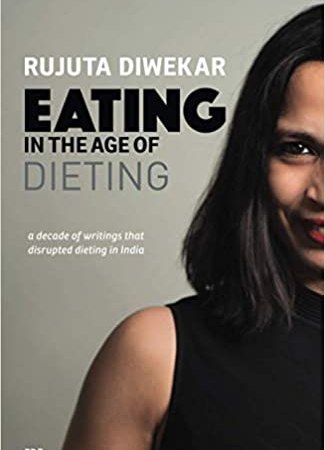I don’t usually review a lot of non fiction books but Eating in the age of dieting by Rujuta Diwekar is just one book I couldn’t resist passing up on. Most of the calorie watchers and avid slimmers in India must have heard her name atleast in the passing. She is a famous nutritionist best known for celeb reviews for her earlier book Don’t lose your mind, lose your weight published more than a decade ago.
Many of her food aphorisms are a part of a well-read foodie’s vocab now. Eat local, think global somehow seems so apt for an era starting from mid 2000’s when our country started catching up with the junk eating, soft drink slopping culture of the west.
Below are some of the broad themes around which the book is built on:
- Food myths and the latest diet misnomers
- Super foods in the kitchen
- Food as a solution for health issues.
- Festival and seasonal foods
- Yoga and exercise as a part of overall fitness regimen.
- Focus on women and children’s health
- Grandmotherly/Heritage recipes
Here is what I liked about the book:
- Treating food as a blessing and not as a cause of your weight woes.
- The frequent references to Upanishads and yoga along with explanations of how the ancient culture of India was wedded to the art of eating. The festival home-made sweets and savouries bingeing had its place as a part of the overall diet just as the Amavasya fasts did. The Bhagawad Gita references to Ayuh, satva, bala, arogya contrast with the recent fads and are not about getting into the latest protein fad diets nor the complete carb/fat avoidance that’s all the rage today.
- Removing myths around carbs as the villain of your weight loss story.
- The proliferation in Diabetes in the country following gluten-free diets.
- Good food is local, seasonal, traditional.
- The food wisdom of your grandmothers in following a traditional diet appreciating the local flavours and fruits/vegetables of the season.
- The secret to flat stomach – hop, skip, jump and not just crunch.
- Yoga, full squats, deadlifts and other cardio exercises play just as important a part in your health as a good diet.
- Finally, accepting that we are beautiful at every size and shape so long as we stay healthy and fit. Metabolic health is the key, not losing weight.
And best of all (my personal favourite), GHEE IS GOOD FOR YOU 🙂
Here’s what could have been better:
- The title says it all – “Eating in the age of dieting” which set the tone for much of the book around the right eating habits but the reader would have benefited from a bit more clarity of how to blend physical activity with the seasonal, local eating that the book covers in detail, for it to have become a much more holistic health guide and not be just a book on how to eat right.
| Book Name: | Eating in the Age of Dieting |
| Author: | Rujuta Diwekar |
| Pages: | 309 pages |
| Publisher: | Westland Publications |
| Release Date: | November 2020 |
| Language: | English |
For more interesting facts about the impact of food on what’s popularly known as “inherited” diseases, read my post on the impact of food and lifestyle on your epigenetics here.
This is not a sponsored post. Opinions are personal.


An excellent glimpse into the book. Sampler platter with the right flavours 😉
LikeLiked by 1 person
😄
LikeLike
[…] food diet fads are ubiquitous amongst overweight and obese millennials in India. While my previous post, a Rujuta Diwekar book review, shed some light on the benefits of Eat local, think global strategy […]
LikeLike
My favourite bit too – Ghee is good for you! 😀 Rujuta Diweker is a legend in her field. Her diets make perfect sense.
LikeLiked by 1 person
We think alike 🌝
LikeLiked by 1 person
[…] components of minerals and vitamins are thought to be equally important. My earlier posts on the traditional types of Indian food and how to eat properly talks about the role of food in the society in the current day and […]
LikeLike
Great post! I think Rujuta’s advice makes sense. She keeps saying we shouldn’t feel guilty about eating.
LikeLiked by 1 person
Exactly! The idea is to just eat the right sort of food.
LikeLiked by 1 person
[…] Book Review: Eating in the age of dieting […]
LikeLike
There has been so much buzz around this book but I couldn’t get myself to read a non-fiction book.
Loved reading the post.
LikeLiked by 1 person
Thanks, regardless of whether we follow Rujuta’s advice, its a good coffee table book for sure.
LikeLike
[…] Eating in the age of dieting […]
LikeLike